(完整版)环境工程专业英语
- 格式:doc
- 大小:18.49 KB
- 文档页数:11
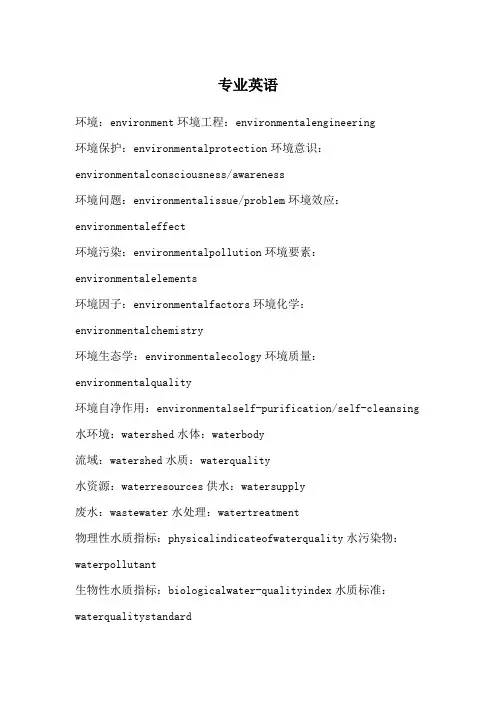
专业英语环境:environment环境工程:environmentalengineering环境保护:environmentalprotection环境意识:environmentalconsciousness/awareness环境问题:environmentalissue/problem环境效应:environmentaleffect环境污染:environmentalpollution环境要素:environmentalelements环境因子:environmentalfactors环境化学:environmentalchemistry环境生态学:environmentalecology环境质量:environmentalquality环境自净作用:environmentalself-purification/self-cleansing 水环境:watershed水体:waterbody流域:watershed水质:waterquality水资源:waterresources供水:watersupply废水:wastewater水处理:watertreatment物理性水质指标:physicalindicateofwaterquality水污染物:waterpollutant生物性水质指标:biologicalwater-qualityindex水质标准:waterqualitystandard化学性水质指标:chemicalwater-qualityindexDS:dissolvedsolidsBOD:biochemicaloxygendemandTDS:totaldissolvedsolidsCOD:chemicaloxygendemand TSS:totalsuspendedsolidsDO:dissolvedoxygenTOC:totalorganiccarbonPH值:TN:总氮totalnitrogenTP:总磷phosphorusZn:zincCu:CopperAs:arsenicCd:CadmiumCr:chromiumNi:NickelHg:mercuryPb:plumbum物理处理:physicaltreatment过滤:screening生物处理:biologicaltreatment沉淀:sedimentation化学处理:chemicaltreatment气浮:flotation物理化学处理:physical-chemicaltreatment蒸发:evaporation稀释:dilution扩散:dispersion吹脱:stripping好氧处理:aerobictreatment生物膜法:bio-membraneprocess 厌氧处理:anaerobictreatment生物滤池:tricklingfilters 活性污泥法:activatedsludgeprocess生物接触氧化:biologicalcontactSBR:苯乙烯-丁二烯StyreneButadieneRubberUASB(流式厌氧污泥床):Upflowanaerobicsludgeblanket活性污泥:activatedsludge改进型:modification一级处理:primarytreatment二级处理:secondarytreatment三级处理:tertiarytreatment高级氧化处理:advancedtreatment生活污水:domesticwastewater 生产废水:industrialwastewater城市生活污水:municipalwastewater电镀废水:metalplatingplants印染废水:pulpandpaperindustrieswastewater浊度:turbidity 硬度:hardness水质净化:waterqualitypurifies混凝沉淀:coagulateflocculatingagent活性炭吸附:activatedcarbonadsorption隔油池:oilseparationtank中和池:neutralizationtank调节池:adjustingtank生物反应池:biologicalreactor加药设备:physicalequipment沉淀池:sedimentationtank初沉池:primarysedimentationtank二沉池:secondarysedimentationtank絮凝剂:flocculant混凝剂:coagulateflocculant生物降解:biodegradation生物累积:bioaccumulation飘尘:floatingdust可吸入颗粒物:inhalableparticles能见度:visibility酸雨:acidrain一次污染物:primarypollutant二次污染物:secondarypollutant氮氧化物:nitrogenoxides 硫氧化物:sulfuroxides硫化氢:hydrogensulfide碳氧化物:carbonoxides硝酸:nitricacid盐酸:hydrochloricacid硫酸:sulfuricacid二氧化硫:sulfurdioxide除尘工艺:Dustremoval吸收:absorption吸附:adsorption静电除尘:electricdustprecipitation重力除尘:gravitationalsettling臭氧:ozone光化学烟雾:photochemicalsmoke喷淋(洗涤):scavenging 土壤:soil热污染:temperaturechange/thermalpollution 噪声:noise放射性:radioactivityEIA:environmentalimpactassessmen tCAD(计算机辅助设计):computeraideddesign大气污染控制工程:airpollutioncontrol水污染控制工程:waterpollutioncontrol 固体废物污染控制工程:solidwastemanagement污染源:pollutionsource同化作用:assimilation固体废物:solidwastes危险废物:hazardouswastes 化学污泥chemicalsludge:生物污泥:biologicalsludge工业固废:industrialwastes分选处理:separationtreatment 矿业固废:minesolidwastes破碎处理:processing农业固废:agriculturesolidwastes压实处理:reductioninvolume污泥脱水:disposalofthesludge?污泥浓缩:sludgethickening 带式压滤:Beltfilterpress 离心脱水:centrifugaldewatering 筛分:screening堆肥和堆肥化:compostandcomposting沼气和沼气化:biogas热解与焚烧:pyrolysisandincineration 生物转化作用:biotransformation热化学转化作用:thermo-chemical固化和稳定化作用:solidificationandstabilizati on资源化:resource减量化:pollutioncontrol无害化:harmlessness固体废物全过程控制:solidwasteintegratedcontrol 固体废物污染控制:solidwasterpollutioncontrol 固体废物处理:processingandrecovery处置:disposal物质回收:materialsrecovery 物质转化:materialconversion 能量回收:energyrecovery能量转化:energyconversion1.Environmentalengineeringhasbeendefinedasthebranchofengineeringthatisconcernedwithprotectingtheenvironmentfromthepotential,deleteriouseffectsofhumanactivity,protectinghuman populationsfromtheeffectsofadverseenvironmentalfactors,andimprovingenvironmentalqualit yforhumanhealthandwell-being.(2页)环境工程学是环境工程的分支学科,其研究内容包括①保护环境免受人类活动改造形成的潜在和不利影响②保护人类免受不利环境因素的影响③持续改善环境质量,以造福于人类健康与福祉。

Unit one Environmental Engineering环境工程What is this book about?这本书是关于什么的?The objective of this book is to introduce engineering and science students to the interdisciplinary study of environment problems;their cause,why they are of concern,and how we can control them. The book includes:这本书的目的是使理工科的学生了解跨学科间的研究环境问题;它们的起因,为什么它们受到关注,以及我们怎样控制它们。
这本书包括:●Description of what is meant by environment and environmental systems描述环境和环境系统意味着什么●Information on the basic causes of environmental disturbances关于引起环境干扰基础原因的基本信息●Basic scientific knowledge necessary to understand the nature of environmental problems and to be able toquantify them理解环境问题本质,并能够定量计算它们所必要的基本科学知识●Current state of the technology of environmental control in its application to water,air and pollution problems目前适用于水,空气和环境污染问题的环境控制技术的现状●Considerable gaps in our current scientific knowledge of understanding and controlling many of the complexinteractions between human activities and nature我们目前的科学知识在理解和控制人类活动和自然之间复杂的相互作用的科学知识上存在相当大的缺陷●Many environmental problems which could be eliminated or reduced by the application of current technology,butwhich are not dealt with because of society’s lack of will to do so,or in many instance because of a lack of resources to do so.许多环境问题可以应用现有技术消除或减少,但没有得到处理是因为社会缺乏这样做的意愿,或者像许多例子那样因为缺乏资源。
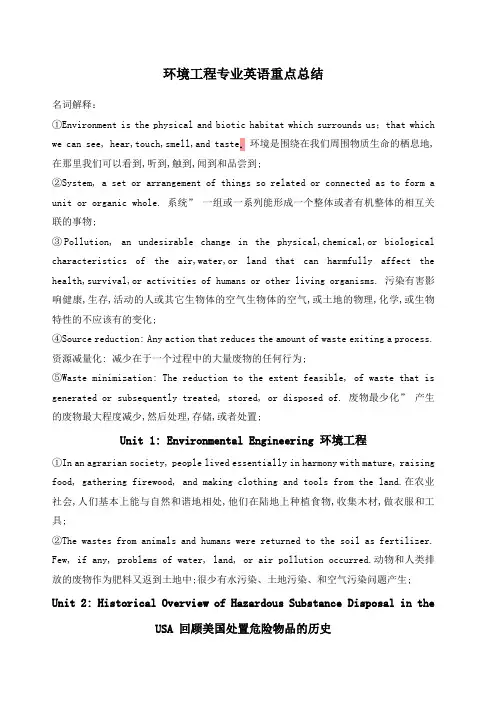
环境工程专业英语重点总结名词解释:①Environment is the physical and biotic habitat which surrounds us;that which we can see, hear,touch,smell,and taste.环境是围绕在我们周围物质生命的栖息地,在那里我们可以看到,听到,触到,闻到和品尝到;②System, a set or arrangement of things so related or connected as to form a unit or organic whole. 系统” 一组或一系列能形成一个整体或者有机整体的相互关联的事物;③Pollution, an undesirable change in the physical,chemical,or biological characteristics of the air,water,or land that can harmfully affect the health,survival,or activities of humans or other living organisms. 污染有害影响健康,生存,活动的人或其它生物体的空气生物体的空气,或土地的物理,化学,或生物特性的不应该有的变化;④Source reduction: Any action that reduces the amount of waste exiting a process. 资源减量化: 减少在于一个过程中的大量废物的任何行为;⑤Waste minimization: The reduction to the extent feasible, of waste that is generated or subsequently treated, stored, or disposed of. 废物最少化” 产生的废物最大程度减少,然后处理,存储,或者处置;Unit 1: Environmental Engineering 环境工程①In an agrarian society, people lived essentially in harmony with mature, raising food, gathering firewood, and making clothing and tools from the land.在农业社会,人们基本上能与自然和谐地相处,他们在陆地上种植食物,收集木材,做衣服和工具;②The wastes from animals and humans were returned to the soil as fertilizer. Few, if any, problems of water, land, or air pollution occurred.动物和人类排放的废物作为肥料又返到土地中;很少有水污染、土地污染、和空气污染问题产生; Unit 2: Historical Overview of Hazardous Substance Disposal in theUSA 回顾美国处置危险物品的历史a result, industries that generated large quantities of these waste materials now had to ensure that the materials were disposed of in the a manner that was safe for the environment.结果导致产生大量废物的企业现在不得不确保这些物以一种对环境更安全的处置方式处理;sufficient legislation is now in place to solve the problem of hazardous waste disposal, it is unlikely that a true solution will be achieved for 20 years or longer.尽管现在有足够的法规来解决有害物质的处理问题,但是在二十年或更长的时间内是不可能真正的解决的;through interaction between industry scientists, and government regulators will true solutions be finally realized.只有通过工业界,科学家和政府部门的共同努力,才能最终得到解决;Unit 5: Type and Sources of Air Pollutants空气污染物的类型和来源geographic location of some heavily populated cities, such as Los Angeles and Mexico City, makes them particularly susceptible to frequent air stagnation and pollution buildup.一些人口稠密的城市的地理位置,例如洛杉矶和墨西哥城,他们特别容易受到频繁的空气停滞和空气污染累积的影响;themselves , measured concentrations tell us nothing about the danger caused by pollutants, because threshold levels, synergy, and biological magnification are also determining factors.通过测出的浓度自身并不能告知我们有关污染物所带来的危险的信息,因为临界浓度、协同作用还有生物放大效应都是决定因素;Unit 6: Effects on Climate and Ecological Environment气候和生态环境的影响induced global warming would be melting of 1. The most sever consequence of CO2the polar ice caps and the subsequent rise of ocean levels and inundation of coastal plains. 二氧化碳引起全球变暖最严重的后果是,极地冰川融化、海平面上升,沿海平原将被淹没;2. Although global warming from the already elevated levels of atmospheric CO2has been predicted by most climatic models, such a warming has not been empirically observed. 虽然很多气候模型预言了大气中二氧化碳水平的升高会引起全球变暖,但是这种变暖并没有实际观察到;3. Confirmation of the effect of CO2on climate has been confounded by the natural fluctuations in climate and average global surface temperatures. 自然气候和全球平均地表温度的波动一直干扰着二氧化碳对气候影响的证实;4. Although they indicate trends in average surface temperatures and climate, they unfortunately coincide with increased industrialization and pollution. 虽然这些记录表明了平均表面温度和气候的发展趋势,遗憾的是,这些记录又碰巧与工业化的增加和污染重合了;uncertainties associated with sink mechanisms considerable complicate the problem of determining the world carbon budget and prediction of future atmosphereCO2 levels.吸收机制的不确定性相当大程度地使世界碳量平衡和预计未来大气 CO2水平问题复杂化;Unit 8: New Technologies of Air Pollution Control大气污染控制的新技术1. Moreover, while bioremediation techniques are now being applied successfully for the treatment of soil and groundwater contaminated by synthetic organics, at present there is very little practical experience with biological systems for the control of air contaminants among environmental professionals in the U S. 而且,生物除污技术在土壤和地下水得到了成功的应用,现在, 美国环保专业人员中,生物学系统在控制大气污染物方面只有很少的实践经验;2. In fact, few environmental professionals in this country appear to be aware that “biofiltration” ., the biological removal of air contaminants from off-gas streams in a solid phase reactor, is now a well established air pollution control APC technology in several European countries, most notably The Netherlands and Germany.实际上,这个国家几乎没有环境的专家似乎意识到在好几个欧洲国家最显着的是荷兰和德国“生物过滤” 即从固相反应器气流中空气污染物的生物去除法是一种充分确立的空气污染控制技术;3. The experiences in Europe have demonstrated that biofiltration has economic and other advantages over existing APC technologies, particularly if applied to off-gas streams that contain only low concentrations typically less than 1000 ppm as methane of air pollutants that are easily biodegraded.欧洲的经验已经证明,生物过滤较已有的空气污染技术有着经济的和其他方面的优越性,特别是用于仅含有低浓度{ 1000ppm}易生物降解的空气污染物的尾气;4. The principal reasons why biofiltration is not presently well recognized in the ., and has been applied in only a few cases, appear to be a lack of regulatory programs, little governmental support for research and development, and lack of descriptions written in the English language. 对于那些为什么生物过滤法如今在美国还不是很好地被认识和只应用于仅仅很少的一些情况的道理,可以认为是缺少控制的计划、来自政府对此技术研究和发展支持,更是缺少用英语写成的有关这些技术的文献;5. While soil beds have been shown to control certain types of odors and VOC efficiently and fairly low and operating cost, their use in the . has been limited by the low biodegradation capacity of soils and the correspondingly large space requirements for the beds. 虽然已经证实土壤床可用想到低的投资和操作费用来控制某些类型的臭味和挥发性有机化合物,但是,土壤的低生物降解能力和相当大的占地要求限制了土壤床在美国的应用;Unit 10: Water Pollution and Pollutants 水污染及其污染源for the few pathogens that might be present are difficult and time consuming, and standard practice is to test for other more plentiful organisms that are always present in the billions in the intestines of warm-blooded animals, including human.对可能存在的病菌的检测不仅有难度并且很耗时,并且标准的实施是对其他许多存在于包括人类在内的热血动物肠道内德有机体进行的检测; 老是强调进行的检测;2. VSS can be an indicator of the organic content of raw wastes and can also providea measure of the active microbial population in biological processes. 挥发性悬浮固体可作为原废物的有机,并为在生物过程活微生物数量提供一个测量方法;3. TOC is determined by measuring the amount of COproduced when the organic carbon2in the sample is oxidized by a strong oxidizer and comparing it with the amount in a standard of known TOC. 总有机碳是通过测量样品中的有机碳在一种强氧化剂的氧化作用下产生的二氧化碳的量,并与已知的总有机碳的标准对比而测得的;Unit 13: Water Treatment Processes 水处理过程1. Coagulation/flocculation is a chemical-physical procedure whereby particles too small for practical removal by plain sedimentation are destabilized and clustered together for faster settling. 混凝/絮凝法是一种化学物理过程, 混凝/絮凝法是一种化学物理过程,那些太小的用普通沉降法不能去除的颗粒具有在这个过程中失去稳定性能成团的特点, 而能较快地沉淀; NOTES 程中失去稳定性能成团的特点,从而能较快地沉淀;Unit 18: Sources and Types of Solid Wastes固体废弃物的来源和种类1. Although any number of source classifications can be developed, the following categories have been found useful.虽然已有许多废物来源的分类法,但以下的分类是很有价值的;2. As a basis for subsequent discussions, it will be helpful to define the various types of solid wastes that are generated.作为以下讨论的基础,定义所产生的各种固体废物是有帮助的;3. The most important characteristic of these waste is that they are highly putrescible and will decompose rapidly, especially in warm weather. 饮食废物的重要特点在于它具有易腐烂性, 尤其在温暖的天气里,会极快地腐烂;4. In addition to the amounts of food wastes generated at residences, considerable amounts are generated at cafeterias and restaurants, large institutional facilities such as hospitals and prisons, and facilities associated with the marketing of foods, including wholesale and retail stores and markets. 除了在家庭产生饮食废物外,在自助食堂、饭馆、医院和监狱等机构,以及诸如批发、零售等食品市场,均会产生大量的饮食废物;Unit 20: Methods of Waste Disposal 废弃物处理方法1. Waste can be pretreated by pulverizing, or mechanically breaking it down intosmall particle sizes, which can reduce the bulk by up to 33% by volume. 废物可以通过粉碎加以预处理,或者把废物粉碎成碎块可以使其体积减少33% 左右;2. In this survey, 72% of waste was tipped on land, 16% of the intractable and dangerous waste was dumped at sea in sealed containers, and % was buried. Only about 3% of the waste was disposed of by the alternative methods of incineration or discharge into sewers. 在这项调查中,72%的废弃物被倾倒在陆地上,16%棘手和危险的废弃物装在密封的容器被倾倒在海里,并%的废弃物被填埋,只有大约 3%的废弃物被焚烧或排入下水沟的选择性方法处理;专业名词:hazardous substance disposal 危险物品处置Resource Conservation and Recovery Act RCRA资源回收保护法Environmental Protection Agency EPA 环境保护署hazardous waste 有害废弃物waste Reduction 废物减量waste Minimization 废物最少化chlorofluoro carbon 含氯氟烃primary air pollution 初级空气污染secondary air pollution 次生空气污染次生空气污染threshold levels 临界浓度synergy 协同作用biological magnification 生物放大效应carbon dioxide 二氧化碳carbon oxides 碳氧化物sulfur dioxide 二氧化硫sulfur oxides 硫氧化物nitric oxide 一氧化氮nitrogen oxides 氮氧化物methane 甲烷hydrocarbons碳氢化合物photochemical oxidants光化学氧化剂Radioactive substances放射性物fossil fuels化石燃料ozone 臭氧without adequate 适当的ventilation 通风aerosol 气溶胶thermal energy 热能emissivity 发射率,辐射系数发射率average global surface temperatures 全球平均地表温度trace gases 痕量气体the centrifugal force 离心力cyclones 旋风分离器fabric filters 布袋过滤器wet scrubbers 湿式洗涤器electrostatic precipitators 静电除尘器impingement plate tower 冲击式板式塔biodegradation 生物降解bioremediation 生物修复volatile organic compounds VOC 挥发性有机化合物sulfur and nitrogen oxides 硫和氮氧化物hydrogen sulfide 硫化氢biodegradable 可生物降解的microorganisms 微生物solids 固体inorganic constituents 无机成分organic matter 有机物质purification 净化。
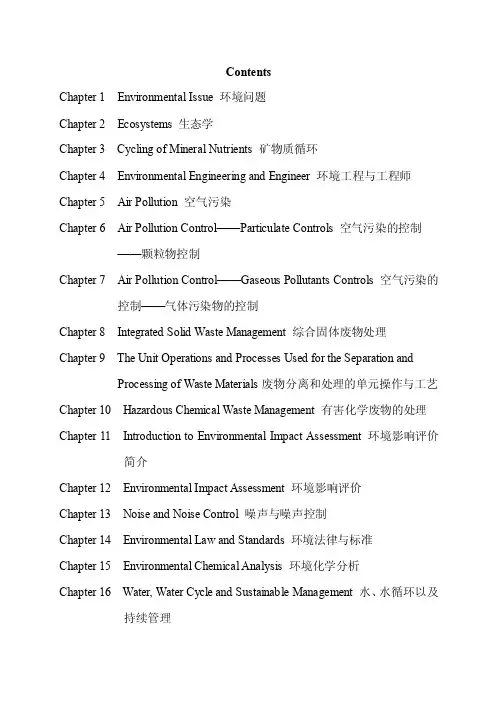
ContentsChapter 1 Environmental Issue 环境问题Chapter 2 Ecosystems 生态学Chapter 3 Cycling of Mineral Nutrients 矿物质循环Chapter 4 Environmental Engineering and Engineer 环境工程与工程师Chapter 5 Air Pollution 空气污染Chapter 6 Air Pollution Control——Particulate Controls 空气污染的控制——颗粒物控制Chapter 7 Air Pollution Control——Gaseous Pollutants Controls 空气污染的控制——气体污染物的控制Chapter 8 Integrated Solid Waste Management 综合固体废物处理Chapter 9 The Unit Operations and Processes Used for the Separation and Processing of Waste Materials废物分离和处理的单元操作与工艺Chapter 10 Hazardous Chemical Waste Management 有害化学废物的处理Chapter 11 Introduction to Environmental Impact Assessment 环境影响评价简介Chapter 12 Environmental Impact Assessment 环境影响评价Chapter 13 Noise and Noise Control 噪声与噪声控制Chapter 14 Environmental Law and Standards 环境法律与标准Chapter 15 Environmental Chemical Analysis 环境化学分析Chapter 16 Water, Water Cycle and Sustainable Management 水、水循环以及持续管理Chapter 17 Water Supply 供水Chapter 18 Wastewater Collection Systems 废水收集系统Chapter 19 Waste Water Engineering 废水工程Chapter 20 Wastewater Treatment Objectives, Methods, and Implementation 废水处理目标,方法和实施Chapter 21 Introduction to Wastewater Treatment Plant Design 污水处理厂设计简介Chapter 22 Wastewater Treatment 废水处理Chapter 23 Biological Nutrient Removal 生物营养物去除Chapter 24 Advanced Wastewater Treatment 高级废水处理Chapter 25 Sludge Treatment and Disposal 污泥处理与处置Chapter 5 Air Pollution 空气污染5.1 Definition of Air Pollution(空气污染的定义)Air pollution can be defined as the presence in the the outdoor atmosphere of one or more contaminants (pollutants)(空气污染可以定义为存在于室外大气中的一种或多种污染物)in such quantities and of such duration as may be (or may tend to be) injurious to human, plant, or animal life, or to property (materials), 其数量和持续时间已达到(或将会)危害人类、植物、动物生命以及财产的程度or which may unreasonably interfere with the comfortable enjoyment of life or property, or the conduct of business.(或妨碍人们对生活财产的舒适享受或影响商业活动。
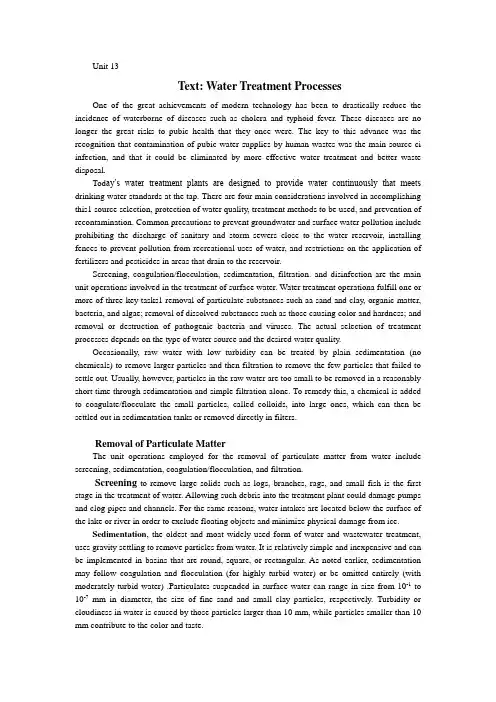
Unit 13Text: Water Treatment ProcessesOne of the great achievements of modern technology has been to drastically reduce the incidence of waterborne of diseases such as cholera and typhoid fever. These diseases are no longer the great risks to pubic health that they once were. The key to this advance was the recognition that contamination of pubic water supplies by human wastes was the main source ci infection, and that it could be eliminated by more effective water treatment and better waste disposal.Tod ay’s water treatment plants are designed to provide water continuously that meets drinking water standards at the tap. There are four main considerations involved in accomplishing this1 source selection, protection of water quality, treatment methods to be used, and prevention of recontamination. Common precautions to prevent groundwater and surface water pollution include prohibiting the discharge of sanitary and storm sewers close to the water reservoir, installing fences to prevent pollution from recreational uses of water, and restrictions on the application of fertilizers and pesticides in areas that drain to the reservoir.Screening, coagulation/flocculation, sedimentation, filtration. and disinfection are the main unit operations involved in the treatment of surface water. Water treatment operationa fulfill one or more of three key tasks1 removal of particulate substances such aa sand and clay, organic matter, bacteria, and algae; removal of dissolved substances such as those causing color and hardness; and removal or destruction of pathogenic bacteria and viruses. The actual selection of treatment processes depends on the type of water source and the desired water quality.Occasionally, raw water with low turbidity can be treated by plain sedimentation (no chemicals) to remove larger particles and then filtration to remove the few particles that failed to settle out. Usually, however, particles in the raw water are too small to be removed in a reasonably short time through sedimentation and simple filtration alone. To remedy this, a chemical is added to coagulate/flocculate the small particles, called colloids, into large ones, which can then be settled out in sedimentation tanks or removed directly in filters.Removal of Particulate MatterThe unit operations employed for the removal of particulate matter from water include screening, sedimentation, coagulation/flocculation, and filtration.Screening to remove large solids such as logs, branches, rags, and small fish is the first stage in the treatment of water. Allowing such debris into the treatment plant could damage pumps and clog pipes and channels. For the same reasons, water intakes are located below the surface of the lake or river in order to exclude floating objects and minimize physical damage from ice.Sedimentation, the oldest and moat widely used form of water and wastewater treatment, uses gravity settling to remove particles from water. It is relatively simple and inexpensive and can be implemented in basins that are round, square, or rectangular. As noted earlier, sedimentation may follow coagulation and flocculation (for highly turbid water) or be omitted entirely (with moderately turbid water) .Particulates suspended in surface water can range in size from 10-1 to 10-7mm in diameter, the size of fine sand and small clay particles, respectively. Turbidity or cloudiness in water is caused by those particles larger than 10 mm, while particles smaller than 10 mm contribute to the color and taste.Coagulation/flocculation is a chemical-physical procedure whereby particles too small for practical removal by plain sedimentation are destabilized sod clustered together for faster settling©. A significant percentage of particulates suspended in water are so small that settling to the bottom of a tank would take days or weeks. These colloidal particles would never settle by plain sedimentation.Coagulation is s chemical process used to destabilize colloidal particles. The exact mechanism is not well understood, but the general ides is to add a chemical which has positively charged colloids to water containing negatively charged colloids. This will neutralize the negative change on the colloids and thus reduce the tendency for the colloids to repel each other. Rapid mixing for a few seconds is required to disperse the coagulant. Gentle mixing, called flocculation, of the suspension is then undertaken to promote particle contact. This is achieved by mechanical mixing through the use of slowly rotating paddles inside the coagulation/flocculation tank, or by hydraulic mixing which occurs when flow is directed over and around baffles in the tank. Detention time in the coagulation/flocculation tank is usually between 20—40 minutes in tanks 3—4m deep. Through the combined chemical/physical process of coagulation/flocculation, the colloidal particles which would not settle out by plain sedimentation are agglomerated to form larger solids called floe. These appear as fluffy growths of irregular shape that are able to entrap small noncoagulaed particles when settling downward. Aluminum sulfate is the most common coagulant but organic polymers may also be used alone or in combination with alum to improve flocculation. The floe suspension is gently transferred from the coagulation/flocculation tanks to settling tanks, or directly to filters where the floes are removed.DisinfectionTo ensure that water is free of harmful bacteria it is necessary to disinfect it. Chlorination® is the most common method of disinfecting public water supplies. Sufficient quantities of chlorine from chlorine gas or hypochlorites are added to treated water to kill pathogenic bacteria. Chlorination is a reliable, relatively inexpensive, and easy disinfection method to use. Other disinfectants include chloramines, chlorine dioxide, other halogens, ozone, ultraviolet light, and high temperature. Ozonation, which has been used extensively in France, is now gaining acceptance in North America, especially as an alternative to prechlorination where natural organics are present. Although effective, ozone does not leave a lasting residual for long-term disinfection.Ozoanation is the disinfection of water by adding ozone, which is a powerful oxidant of inorganic and organic impurities. Its advantages over chlorine are that it leaves no tastes or odors, and unlike chlorine, it apparently does not react with natural organics to form compounds hazardous to humans.Removal of Dissolved SubstancesAeration is used to remove excessive amounts of iron and manganese from groundwater. These substances cause taste and color problems, interfere with laundering, stain plumbing fixtures, and promote the growth of iron bacteria in water mains. By bubbling air through water, or by creating contact between air and water by spraying, dissolved iron or manganese (Fe2+ , Mn2+) is oxidized to a less soluble form (Fe3+ , Mn4+), which precipitates out and can be removed in s settling tank or filter. Aeration also removes odors caused by hydrogen sulfide (H2S) gas.Softening of water is a process that removes hardness, caused by the presence of divalent metallic ions, principally Ca2+ and Mg2+. Hardness in water is the result of contact with soil and rock, particularly limestone, in the presence of CO2.Activated Carbon is an extremely adsorbent material used in water treatment to remove organic contaminants. Activated carbon is produced in a two-stage process. First, a suitable base material such as wood, pest, vegetable matter, or bone is carbonized by heating the material in the absence of air. Then the carbonized material is activated by heating it in the presence of air, CO2 , or steam to burn off any tars it has and to increase its pore size. Adsorption of gases, liquids, and solids by activated carbon is influenced by the temperature and pH of the water as well the complexity of the organics being removed.In reverse osmosis (RO), fresh water is forced through a semipermeable membrane in the direction opposite to that occurring in natural osmosis. Because the membrane removes dissolved salts, the main application for RO has been in desalination. However, the process also removes organic materials, bacteria, and viruses, and its application in water treatment is growing.。
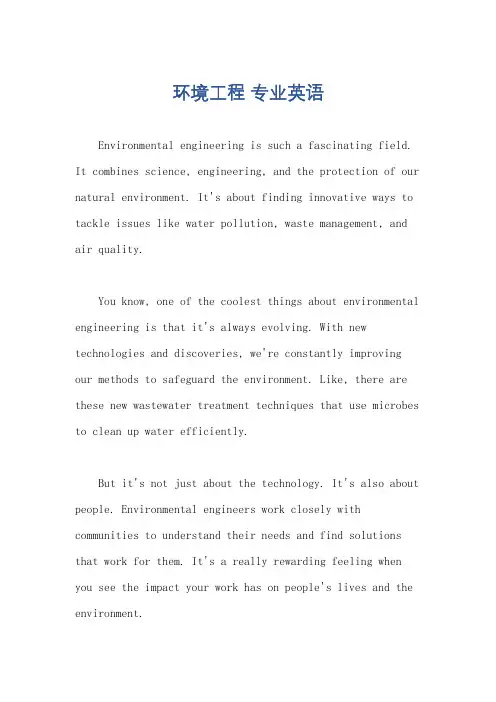
环境工程专业英语Environmental engineering is such a fascinating field. It combines science, engineering, and the protection of our natural environment. It's about finding innovative ways to tackle issues like water pollution, waste management, and air quality.You know, one of the coolest things about environmental engineering is that it's always evolving. With new technologies and discoveries, we're constantly improving our methods to safeguard the environment. Like, there are these new wastewater treatment techniques that use microbes to clean up water efficiently.But it's not just about the technology. It's also about people. Environmental engineers work closely with communities to understand their needs and find solutions that work for them. It's a really rewarding feeling when you see the impact your work has on people's lives and the environment.And speaking of impact, environmental engineering is crucial for sustainable development. It helps us find waysto balance the needs of today without compromising theneeds of future generations. That means thinking long-term, about things like resource management and energy efficiency.Plus, it's a pretty hands-on field. Environmental engineers get to work on real-world projects, fromdesigning wastewater treatment plants to developing new recycling methods. It's exciting to see your ideas and designs come to life and make a difference.So in a nutshell, environmental engineering is about innovation, people, sustainability, and making a difference. It's a field that's constantly evolving and full of opportunities to tackle some of the most pressing environmental issues of our time.。
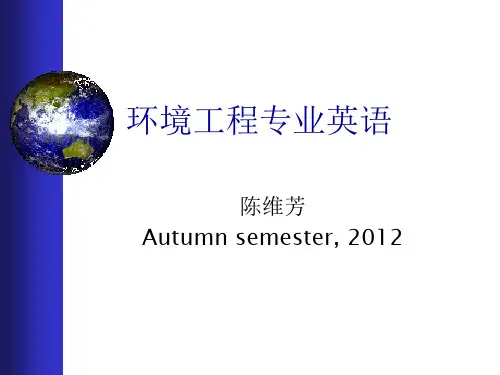
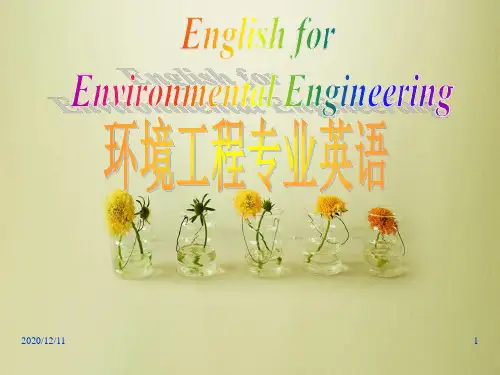
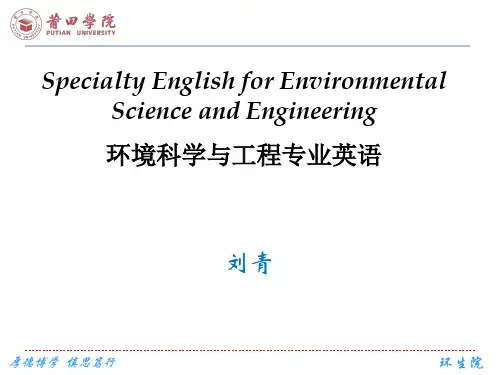
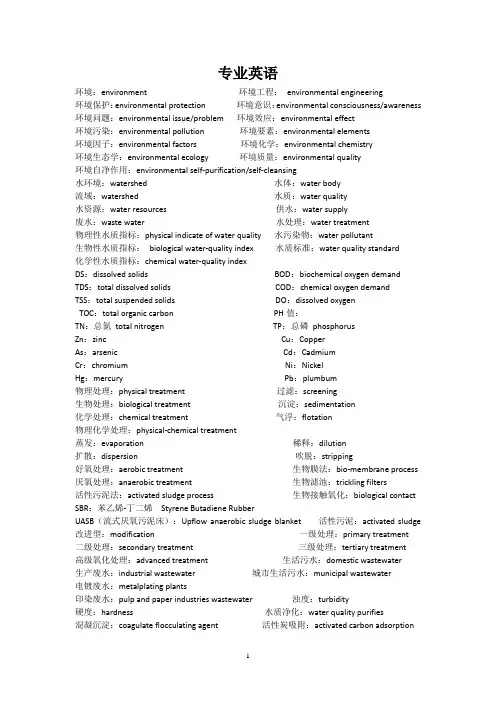
专业英语环境:environment 环境工程:environmental engineering环境保护:environmental protection 环境意识:environmental consciousness/awareness 环境问题:environmental issue/problem 环境效应:environmental effect环境污染:environmental pollution 环境要素:environmental elements环境因子:environmental factors 环境化学:environmental chemistry环境生态学:environmental ecology 环境质量:environmental quality环境自净作用:environmental self-purification/self-cleansing水环境:watershed 水体:water body流域:watershed 水质:water quality水资源:water resources 供水:water supply废水:waste water 水处理:water treatment物理性水质指标:physical indicate of water quality 水污染物:water pollutant生物性水质指标:biological water-quality index 水质标准:water quality standard化学性水质指标:chemical water-quality indexDS:dissolved solids BOD:biochemical oxygen demand TDS:total dissolved solids COD:chemical oxygen demand TSS:total suspended solids DO:dissolved oxygenTOC:total organic carbon PH值:TN:总氮total nitrogen TP:总磷phosphorusZn:zinc Cu:CopperAs:arsenic Cd:CadmiumCr:chromium Ni:NickelHg:mercury Pb:plumbum物理处理:physical treatment 过滤:screening生物处理:biological treatment 沉淀:sedimentation化学处理:chemical treatment 气浮:flotation物理化学处理:physical-chemical treatment蒸发:evaporation 稀释:dilution扩散:dispersion 吹脱:stripping好氧处理:aerobic treatment 生物膜法:bio-membrane process 厌氧处理:anaerobic treatment 生物滤池:trickling filters活性污泥法:activated sludge process 生物接触氧化:biological contact SBR:苯乙烯-丁二烯Styrene Butadiene RubberUASB(流式厌氧污泥床):Upflow anaerobic sludge blanket 活性污泥:activated sludge 改进型:modification 一级处理:primary treatment二级处理:secondary treatment 三级处理:tertiary treatment高级氧化处理:advanced treatment 生活污水:domestic wastewater生产废水:industrial wastewater 城市生活污水:municipal wastewater电镀废水:metalplating plants印染废水:pulp and paper industries wastewater 浊度:turbidity硬度:hardness 水质净化:water quality purifies混凝沉淀:coagulate flocculating agent 活性炭吸附:activated carbon adsorption隔油池:oil separation tank 中和池:neutralization tank调节池:adjusting tank 生物反应池:biological reactor加药设备:physical equipment 沉淀池:sedimentation tank初沉池:primary sedimentation tank 二沉池:secondary sedimentation tank絮凝剂:flocculant 混凝剂:coagulate flocculant生物降解:biodegradation 生物累积:bioaccumulation飘尘:floating dust 可吸入颗粒物:inhalable particles能见度:visibility 酸雨:acid rain一次污染物:primary pollutant二次污染物:secondary pollutant 氮氧化物:nitrogen oxides硫氧化物:sulfur oxides硫化氢:hydrogen sulfide 碳氧化物:carbon oxides硝酸:nitric acid 盐酸:hydrochloric acid硫酸:sulfuric acid 二氧化硫:sulfur dioxide除尘工艺:Dust removal吸收:absorption 吸附:adsorption静电除尘:electric dust precipitation 重力除尘:gravitational settling臭氧:ozone光化学烟雾:photochemical smoke 喷淋(洗涤):scavenging土壤:soil 热污染:temperature change/thermal pollution 噪声:noise 放射性:radioactivityEIA:environmental impact assessment CAD(计算机辅助设计):computer aided design大气污染控制工程:air pollution control水污染控制工程:water pollution control固体废物污染控制工程:solid waste management污染源:pollution source同化作用:assimilation 固体废物:solid wastes危险废物:hazardous wastes化学污泥chemical sludge:生物污泥:biological sludge工业固废:industrialwastes 分选处理:separation treatment 矿业固废:mine solid wastes 破碎处理:processing农业固废:agriculture solid wastes 压实处理:reduction in volume污泥脱水:disposal of the sludge ?污泥浓缩:sludge thickening带式压滤:Belt filter press离心脱水:centrifugal dewatering筛分:screening堆肥和堆肥化:compost and composting沼气和沼气化:biogas热解与焚烧:pyrolysis and incineration生物转化作用:biotransformation热化学转化作用:thermo-chemical固化和稳定化作用:solidification and stabilization资源化:resource减量化:pollution control无害化:harmlessness固体废物全过程控制:solid waste integrated control固体废物污染控制:solid waster pollution control固体废物处理:processing and recovery处置:disposal物质回收:materials recovery 物质转化:material conversion能量回收:energy recovery 能量转化:energy conversion1.Environmental engineering has been defined as the branch of engineering that is concernedwith protecting the environment from the potential, deleterious effects of human activity, protecting human populations from the effects of adverse environmental factors, and improving environmental quality for human health and well-being.(2页)环境工程学是环境工程的分支学科,其研究内容包括①保护环境免受人类活动改造形成的潜在和不利影响②保护人类免受不利环境因素的影响③持续改善环境质量,以造福于人类健康与福祉。
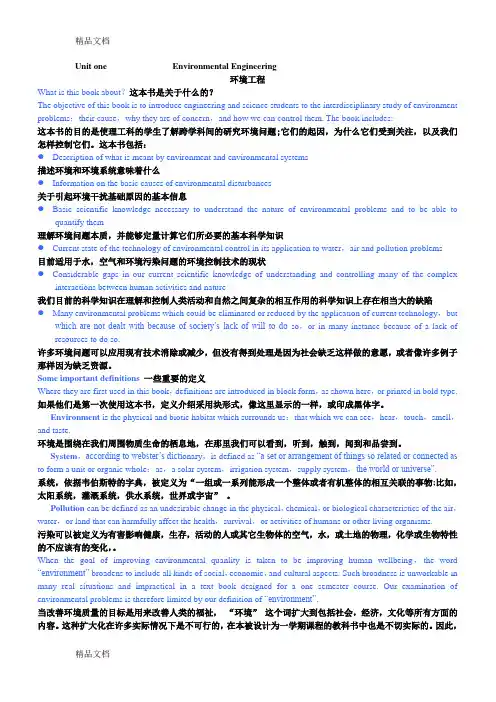
Unit one Environmental Engineering环境工程What is this book about?这本书是关于什么的?The objective of this book is to introduce engineering and science students to the interdisciplinary study of environment problems;their cause,why they are of concern,and how we can control them. The book includes:这本书的目的是使理工科的学生了解跨学科间的研究环境问题;它们的起因,为什么它们受到关注,以及我们怎样控制它们。
这本书包括:●Description of what is meant by environment and environmental systems描述环境和环境系统意味着什么●Information on the basic causes of environmental disturbances关于引起环境干扰基础原因的基本信息●Basic scientific knowledge necessary to understand the nature of environmental problems and to be able toquantify them理解环境问题本质,并能够定量计算它们所必要的基本科学知识●Current state of the technology of environmental control in its application to water,air and pollution problems目前适用于水,空气和环境污染问题的环境控制技术的现状●Considerable gaps in our current scientific knowledge of understanding and controlling many of the complexinteractions between human activities and nature我们目前的科学知识在理解和控制人类活动和自然之间复杂的相互作用的科学知识上存在相当大的缺陷●Many environmental problems which could be eliminated or reduced by the application of current technology,butwhich are not dealt with because of society’s lack of will to do so,or in many instance because of a lack of resources to do so.许多环境问题可以应用现有技术消除或减少,但没有得到处理是因为社会缺乏这样做的意愿,或者像许多例子那样因为缺乏资源。
Unit one Environmental Engineering环境工程What is this book about?这本书是关于什么的?The objective of this book is to introduce engineering and science students to the interdisciplinary study of environment problems;their cause,why they are of concern,and how we can control them. The book includes:这本书的目的是使理工科的学生了解跨学科间的研究环境问题;它们的起因,为什么它们受到关注,以及我们怎样控制它们。
这本书包括:●Description of what is meant by environment and environmental systems描述环境和环境系统意味着什么●Information on the basic causes of environmental disturbances关于引起环境干扰基础原因的基本信息●Basic scientific knowledge necessary to understand the nature of environmental problems and to be able toquantify them理解环境问题本质,并能够定量计算它们所必要的基本科学知识●Current state of the technology of environmental control in its application to water,air and pollution problems目前适用于水,空气和环境污染问题的环境控制技术的现状●Considerable gaps in our current scientific knowledge of understanding and controlling many of the complexinteractions between human activities and nature我们目前的科学知识在理解和控制人类活动和自然之间复杂的相互作用的科学知识上存在相当大的缺陷●Many environmental problems which could be eliminated or reduced by the application of current technology,butwhich are not dealt with because of society’s lack of will to do so,or in many instance because of a lack of resources to do so.许多环境问题可以应用现有技术消除或减少,但没有得到处理是因为社会缺乏这样做的意愿,或者像许多例子那样因为缺乏资源。
环境工程专业英语pollution污染acid rain酸雨environmental problem 环境问题environmental disturbance环境破坏biotic habitat 生物环境sulfur dioxide二氧化硫nitrogen oxide氧化氮carbon dioxide二氧化碳automobile exhaust汽车尾气infectious diseases有传染性的疾病waterborne diseases水传染的疾病agrarian society农业社会industrial society工业社会industrial revolution产业革命urbanization城市化industrialization工业化developed country发达国家developing country发展中国家undeveloped country落后国家primary air pollutant一次大气污染物secondary air pollutant二次大气污染物monoxide一氧化物dioxide二氧化物trioxide三氧化物carbon monoxide一氧化碳carbon dioxide二氧化碳sulfur dioxide二氧化硫sulfur trioxide三氧化硫nitrous oxide一氧化二氮nitric oxide一氧化氮nitrogen dioxide二氧化氮carbon oxides碳氮化物sulfur oxides硫氧化物nitrogen oxides氮氧化物hydrocarbons碳氢化合物photochemical oxidants光化学氧化物particulates颗粒物inorganic compound无机化合物organic compound有机化合物radioactive substance放射性物质heat热noise噪声contaminant污染物strength强度foreign matter杂质domestic sewage生活污水municipalwastewater城市废水microbe微生物microorganism微生物bacteria细菌total solids总固体inorganic constituents无机要素suspended solids (SS)固体悬浮物volatile suspended solids (VSS)挥发性悬浮固体颗粒organic matter有机物质total organic carbon, TOC 总有机碳chemical oxygen demand, COD化学需氧量biochemical oxygen demand, BOD生化需氧量biodegradable可微生物分解的contamination污染recontamination再污染groundwater地下水surface water地表水restriction限制colloid胶体screening隔栅coagulation凝聚flocculation絮凝sedimentation沉淀filtration过滤disinfection消毒chlorination氯化消毒prechlorination预加氯ozonation臭氧消毒aeration曝气softening软化activated carbon活性炭adsorption吸附reverse osmosis反渗透desalination脱盐处理microbial degradation微生物降解biological degradation生化降解biofilm process生物膜法activated sludge process活性污泥法attached-growth吸着生长suspended-growth悬浮生长shock loading冲击负荷organic loading有机负荷mixed liquor suspended solids混合液悬浮固体metabolize使代谢化metabolism新陈代谢dissolved oxygen 溶解氧pretreatment process 预处理工艺primary clarifier初沉池equalization basin均质池biological treatment process生物处理工艺aeration basin曝气池secondary clarifier二沉池biomass生物质heterotrophic bacteria异养菌autotrophic bacteria自养菌hydraulic retention time (HRT) 水力停留时间sludge residence time (SRT) 污泥停留时间solid waste固体废物municipal城市化industrial工业的agricultural农业的hazardous危险的residential住宅的commercial商业的putrescible易腐烂的combustible易燃的flammable可燃的explosive易爆的radioactive放射性的Landfilling土地填埋incineration: 焚烧composting: 堆肥compaction: 压实,紧凑sanitary landfill卫生填埋balance剩下的,余额,结余batch-fed 分批投料refuse垃圾municipal waste城市垃圾perform: 执行shut down: 关闭energy recovery能量回收incomplete combustion不完全燃烧combustion燃烧volume reduction体积缩小anaerobic厌氧硝化中英互译短语Biological degradation生化降解equalization basin调节池aeration basin曝气池sludge blocs 污泥絮体settling tank沉淀池dissolved oxygen溶解氧suspended-growth悬浮生长pulverized refuse垃圾破碎biofilm生物膜well-compacted landfill压实填埋场nutrient source 营养源mass-burning大量燃烧fluidized fed incarceration硫化床燃烧法soil conditioners土壤改良剂温室效应greenhouse effect 由CO2引起的caust by CO2 世界碳预算the world carbon budget 天气自然波动natural fluctuations 全球变暖global warming 厌氧的anaerobic 腐烂Putrefied 甲烷methane 臭氧层ozone layer 气候模型climatic model 正常浓度:normal concentration 严重污染物:heavily polluted 决定因素:determining factor 光化学氧化物:photochemical oxidants 液体微滴:liquid particulates 含硫的:sulfur-containing 放射性物质:radioactiue substance 汽车尾气:automobile exhaust wet oxidation湿式氧化1、Environment is the physical and biotic habitat which surrounds us; that which we can see, hear, touch, smell, and taste. 环境是我们周围的物理和生物环境,我们可以看到、听到、接触到、闻到和品尝到的。
2、Pollution can be defined as an undesirable change in the physical, chemical, or biological characteristics of the air, water, or land that can harmfully affect the health, survival, or activities of humans or other living organisms污染可以定义为大气、水或者土壤在物理、化学或者生物方面的特征所产生的不愉快的变化,它对人类的健康、生存和活动或者其他的有机体都产生了有害的影响。
3、Two examples of interaction between systems that cause major environmental disturbances are presented-the buildup of atmospheric carbon dioxide, a global problem, and the acid rain problem, normally of regional nature目前大气中二氧化碳的增多,是一个全球性的问题,还有酸雨问题,一般来说它都具有一定的区域特性,这就是两个关于系统之间的相互联系而产生重大环境问题的例子。
4、With these improvements, however, have come disturbing side effects, such as lost arable land, disappearing forests, environmental pollution, and new organisms resistant to controls. 经过这些进步,尽管还是有一些破坏性的影响,例如耕地、森林的消失,环境的污染和新的生物反抗的控制5、Both phenomena, urbanization and industrialization, were and are fundamental causes of water and air pollution which the cities of that time were unable to handle.城市化和工业化两者的现象,是过去和现在水污染和大气污染的根本原因,在过去这些城市是处理不了的6、Rapid advances in technology for the treatment of water and the partial treatment of wastewater took place in the developed countries over the next few decades.在接下来的几十年理发达国家,在水治理和部分废水治理技术方面都取得了快速的进展。